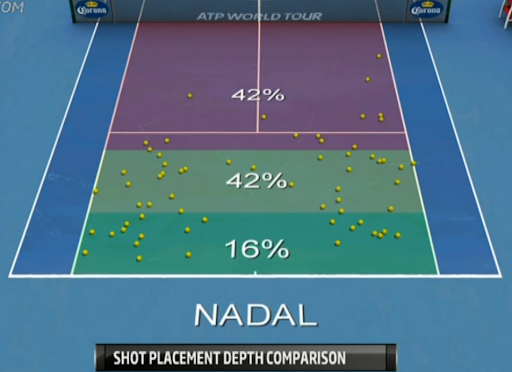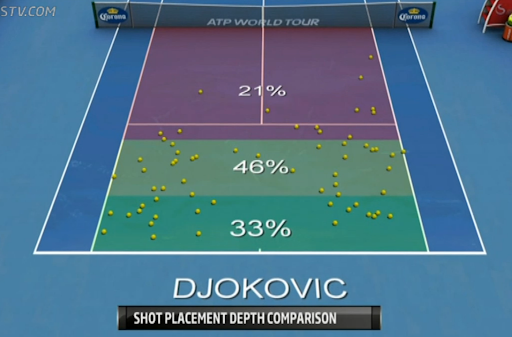Yes, I said it. But before you accuse me of heresy, note the phrasing – I didn’t say that depth is overrated, just that training it is. I’ll provide two arguments as to why, and then we'll look at what qualities to focus on instead and how to train them.
Why it's overrated
The first argument is statistical: the pros don’t hit nearly as deep as most people think. I couldn’t begin to count how many times I’ve walked past a court with a coach telling a player to hit past the ¾ court line or deeper. Take a look at the following graphics:
Notice anything? In every case, more balls are hit between the service line and the ¾ court line than are hit between the ¾ court line and the baseline. That might be expected of a player like Nadal, who plays with more spin, but what about Kvitova, or Sharapova, or Djokovic? All three of them hit more shots in front of the ¾ court line than past it. Now, I’m not saying that a good, deep ball is not effective. It’s just a question of when and why. I would bet that a majority of the balls hit past ¾ court are hit by a player who is in control of the point (that’s the “when”) and the rest… are just luck (that’s the “why”). Don’t get me wrong – I’m sure most players are trying to hit deep. I’m just saying it’s unreasonable to expect a player to be able to consistently hit past ¾ court if even the best in the world can’t do it. If it happens, great! But if not, there are other determiners of a ball’s quality, which we’ll get into later.
The second flaw in training depth is twofold. First, depth is a combination of speed, height, and spin, and when training depth, it is often left up to the judgment of the player which of these factors they should change. Should they hit higher? Should they hit harder? Or should they reduce the spin? This does the player no good and highlights why depth is such an elusive quality – one must be able to manipulate 3 ball controls at once. Second, because depth is a combination of speed, height, and spin, many players go about getting depth in ways that are technically or tactically counterproductive. Take for example the player who hits deeper by lifting and spinning the ball. While it may accomplish the task, it will likely leave a sitting ball that can be attacked. Another player might try to hit deeper by reducing the spin, leading to a low, flat ball that can be inconsistent and might sit right in the opponent's strike zone.
What to focus on instead
We can’t ignore the fact that certain players’ balls are “heavy”, or “penetrating”. What is it that makes them so? Of course, depth plays a role – a ball bouncing inside the service line is not going to do as much damage as a ball bouncing past it. But outside of that, there are two terms that are often overlooked: tempo and weight.
Tempo is the measurement of the time in between shots in a rally, and there is a very strong correlation between tempo and level of play. That is to say, the average tempo increases steadily from U12 to U18 and from Futures to ATP Tour. The same cannot be said for depth.
In fact, I would say that the ability to maintain coordination and technique at higher and higher tempos is one of the key determining factors of success in tennis. Take a look at a player ranked 150 in the world and compare them to a player ranked 500 in the world. Barring any abnormalities, you will not be able to tell which player is better based solely on observing their strokes. But I’d bet that one player can sustain a higher tempo for longer than the other.
Weight is the combination of speed and spin that challenges an opponent’s timing. Of course, what that combination is depends on gamestyle and gender – we all know that women hit much flatter than men. However, independent of individual differences, there is still value in finding the "sweet spot", because if your ball is too spinny, it will be weak and sit up; if it's too flat, it will be inconsistent. And before you say it, yes, Nadal hits with more spin than the others, and no, his ball doesn’t sit up. Why? Because he still maintains tempo.
How to train tempo and weight
Timed drills
Timed drills are a great way to measure and train tempo. The most common one we use is the 10 Ball Time. Start the clock when the first ball is hit and stop the clock when the 10th ball touches the ground. Take the average of three consecutive rallies.
10 Ball Time Norms for International Level Players
Another is the 1 minute drill: in 1 minute, count the total balls hit. Or, time how long it takes to hit 100 total balls. The options are endless.
Peak of bounce training
Measuring and training the peak of the bounce is crucial to improving the weight of one’s rally ball. The peak of the bounce is where the ball is when it reaches its highest point after the bounce. The higher the level, the deeper in the court the peak will be. National level players should be aiming to have their ball peak 3-4 feet past the baseline. At an international level, that distance may be closer to 5 or 6 feet.
Remember, players must not only be able to send heavy balls, but also receive them. Therefore, live ball drills where both players are trying to send a heavy ball are of great importance. Once again, the only limit is your imagination. You can count how many balls peak past the baseline in 1 minute, or you can play games where the first player to hit a ball that doesn't peak deep enough loses the point.
So the next time you're watching a match, no matter the level, take out your phone and time a few rallies. Try to get an average, and compare it to players of different levels. And instead of watching for depth, watch for the peak of the bounce, and see how it correlates with the damage being done to the opponent.













Comentarios